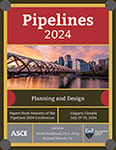Pipe Diameter Is a Dominant Factor in Pipe Failure Risk
Publication: Pipelines 2024
ABSTRACT
Pipe diameter is a key factor in water main design. Decisions around what diameter to use are generally driven by hydraulic considerations, such as offering sufficient flows and residual pressures during fire suppression usage. Considerations of the relative failure risks of different diameters are rarely taken into account; however, this novel research finding suggests that diameter is a much more significant factor than was previously understood. Previous studies have noted that small diameter mains are responsible for more leaks than transmission mains, and that customer services suffer more leaks than either of the two. These observations have come through the professional observations of experienced engineers and from small scale studies. Other observations have noted potential errors in the theory underpinning the design standards for small diameter pipe. None of these have previously translated to a systematic examination of the relationship between diameter and failure risk. This paper presents a novel finding of an inverse-linear relationship between pipe diameter and failure risk per unit length of pipe. This finding is supported by the largest database of pipe failure records ever compiled, including over 10 million pipe-years of records from nine utilities across North America, Europe, and Asia. These records show a clear and strong negative correlation between diameter and failure risk across all pipe materials. When the inverse of diameter is considered, the relationship with failure risk appears to be linear for many materials. This relationship has two major implications. First and foremost, the fact that small diameter pipes fail as much as 100x as frequently as large diameter mains should be incorporated into risk considerations during pipe design and asset management decisions. Second, it offers a novel and useful normalization: failures per million pipe diameters of length per year. This normalization provides a more robust and consistent measure of failure risk than the industry norms of failures per 1,000 pipes per year or failures per 100 km (or 100 mi) per year. That in turn allows the actual failure risk posed by other factors (in particular pipe material, which often correlates with diameter) to be more clearly demonstrated, exposing some misconceptions about the relative risk of different pipe materials.
Get full access to this chapter
View all available purchase options and get full access to this chapter.
REFERENCES
Adams, A. J., Grundy, K. C., Kelly, C. M., Lin, B., and Moore, P. W. (2018). The Barlow Equation for Tubular Burst: A Muddled History. Society of Petroleum Engineers - IADC/SPE Drilling Conference and Exhibition, DC 2018, 2018-March. https://doi.org/10.2118/189681-ms.
Capecchi, D., and Ruta, G. (2015). Strength of Materials and Theory of Elasticity in 19th Century Italy: A Brief Account of the History of Mechanics of Solids and Structures. Advanced Structured Materials, 52. https://doi.org/10.1007/978-3-319-05524-4.
Hu, Y., and Hubble, D. W. (2007). Factors contributing to the failure of asbestos cement water mains. Canadian Journal of Civil Engineering 34, 608–621. <https://doi.org/10.1139/l06-162>.
Kettler, A. J., and Goulter, I. C. (1985). An analysis of pipe breakage in urban water distribution networks. Canadian Journal of Civil Engineering 12, 286–293. <https://doi.814org/10.1139/l85-030>.
Lambert, A. (2000). What Do We Know About Pressure: Leakage Relationships in Distribution Systems? IWA Conference on Systems Approach to Leakage Control and Water Distribution System Management, 1–8.
Makar, J. M., Desnoyers, R., and McDonald, S. E. (2001). Failure Modes and Mechanisms in Gray Cast Iron Pipes. Underground Infrastructure Research. <https://doi.org/10.1201/9781003077480-47>.
Pelletier, G., Mailhot, A., and Villeneuve, J. P. (2003). Modeling Water Pipe Breaks—Three Case Studies. Journal of Water Resource Planning & Management 129, 115–123. <https://doi.org/10.1061/(ASCE)0733-9496(2003)129:2(115)>.
Selvadurai, A. P. S., and Shinde, S. B. (1993). Frost Heave Induced Mechanics of Buried Pipelines. Journal of Geotechnical Engineering, 119(12), 1929–1951. <https://doi.org/10.1061/(ASCE)0733-9410(1993)119:12(1929)>.
Yu, P. J., Nie, J. X., Xu, G., Long, Z. H., Wang, Z. H., Tu, Y., Li, B., He, X., and Chen, Y. L. (2012). Study of Failure Rate Model for a Large-Scale Water Supply Network in Southern China Based on Different Diameters. In Applied Mechanics and Materials (Vols. 260–261, pp. 1200–1205). Trans Tech Publications, Ltd. <https://doi.org/10.4028/www.scientific.net/amm.260-261.1200>.
Information & Authors
Information
Published In
History
Published online: Aug 30, 2024
Authors
Metrics & Citations
Metrics
Citations
Download citation
If you have the appropriate software installed, you can download article citation data to the citation manager of your choice. Simply select your manager software from the list below and click Download.
